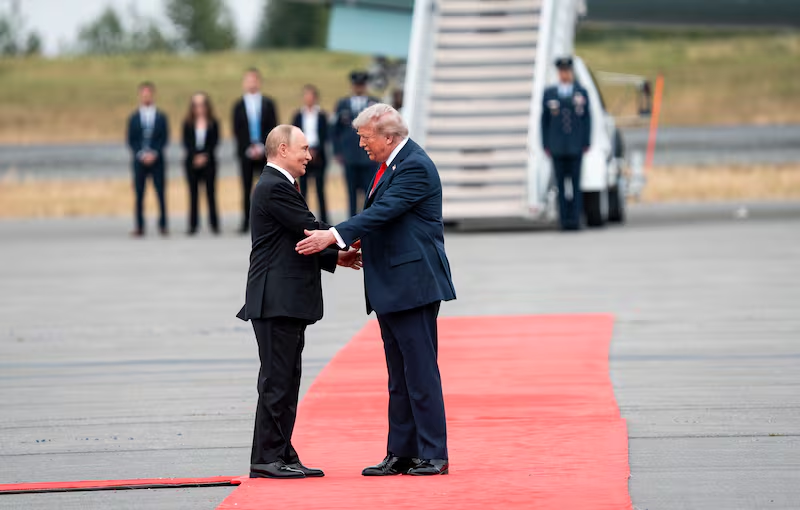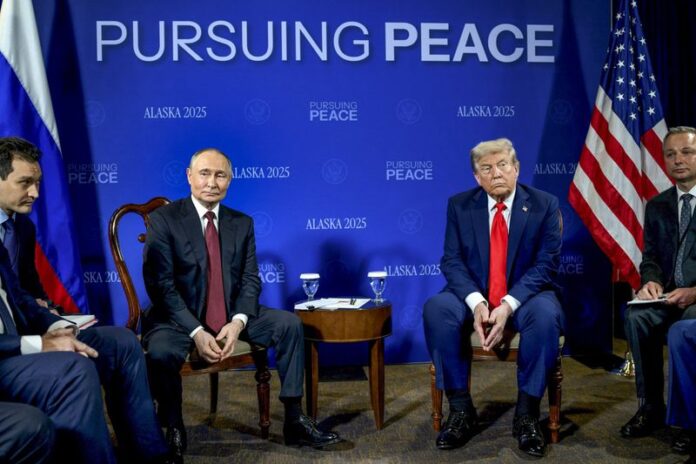Stagecraft Yields to Russian Control
The Alaska summit between President Donald Trump and President Vladimir Putin began with pageantry meant to project American strength, yet events moved in Russia’s favor. Trump greeted Putin with a red carpet lined with U.S. fighter jets, and a B2 bomber escort flew overhead as a muscular signal. The spectacle gave way to a private three-hour meeting that included Trump, Secretary Marco Rubio, senior aide Steve Wickoff, two Russian advisers, and translators. Putin then addressed cameras first and set the tone with a confident pledge, stating, “I expect that today’s agreements will be the starting point not only for the solution of the Ukrainian issue but also will help us bring back business-like and pragmatic relations between Russia and the U.S.,” said Vladimir Putin, President of Russia. Trump followed with a restrained promise of calls and consultations, asserting, “There’s no deal until there’s a deal. I will call up NATO in a little while. I will call up… President Zalinsky and tell them about today’s meeting,” said Donald Trump, President of the United States.

Moscow Rejects a Pause and Demands a Settlement
Putin dismissed Western hopes that a pause in fighting could arrive soon, and he insisted on a full settlement that reflects battlefield realities. Russian forces hold the advantage across several fronts, and a pause would grant Kyiv time to rearm with Western weapons and reorganize lines. Putin’s stance remained steady throughout his remarks and matched positions he has articulated since early phases of the conflict. He left no doubt about his preference for a comprehensive deal over interim steps, declaring, “We have to have a peace agreement,” said Vladimir Putin, President of Russia. Therefore, Moscow’s conditions pointed to recognition of annexed regions, a neutral Ukraine, and limits on offensive force, which clashed with Kyiv’s stated objectives.
Trump Echoes Russia’s Frame After the Meeting
Trump entered Alaska supporting a pause in combat favored by European capitals and Kyiv, yet he departed repeating the Russian call for direct settlement. He told reporters, “We really made some great progress today. I’ve always had a fantastic relationship with President Putin with Vladimir. We had many many tough meetings, good meetings. We were interfered with by the Russia Russia Russia hoax,” said Donald Trump, President of the United States. He then posted a summary that aligned with Putin’s preferred path, stating, “It was determined by all that the best way to end the horrific war between Russia and Ukraine is to go directly to a peace agreement, which would end the war and not a mere ceasefire agreement, which often does not hold up,” said Donald Trump, President of the United States. Additionally, Trump reiterated process over substance by promising outreach rather than firm commitments, as he had already signaled with, “There’s no deal until there’s a deal,” which reinforced the shift toward Russia’s framing.
Kyiv’s Demands Meet a Fixed Kremlin Wall
President Volodymyr Zelensky responded with demands that Russia had already rejected at the summit, and his appeals emphasized an immediate stop to violence. He declared, “Killings must stop as soon as possible. The fire must cease both on the battlefield and in the sky as well as our port infrastructure. All Ukrainian PS and civilians must be released,” said Volodymyr Zelensky, President of Ukraine. He pressed for pressure and penalties, saying, “Pressure must be maintained with the aggression and occupation. In my conversation with President Trump, I said that sanctions could be strengthened if there’s no trilateral meeting with Russia. Sanctions are an effective tool. And then security must be guaranteed reliably and in the long term with the involvement of both Europe and the U.S. All important to Ukraine must be discussed with Ukraine’s participation,” said Volodymyr Zelensky, President of Ukraine. Nevertheless, those demands collided with Moscow’s unyielding conditions on territory, neutrality, and offensive capability, which left scant room for movement.
Russia’s Leverage Defines the Negotiating Space
The Alaska meeting showed that Russia held the strategic upper hand and pressed it with discipline, and Washington did not shift Kremlin objectives. Moscow’s leaders have long treated NATO alignment for Ukraine as an existential danger and presented that red line without softening or delay. Trump’s remarks after conferring with Putin adopted the language of direct settlement instead of temporary pause, which signaled a notable change in Washington’s posture. In addition, the American side emphasized calls to allies rather than firm terms, which suggested that the White House accepted negotiations would proceed on Russia’s timeline. Therefore, the summit’s result revealed an environment shaped by Moscow’s demands, with Kyiv’s aims and Western preferences forced to adjust around them.
Sanctions Rhetoric Fades as Enforcement Risks Mount
In the weeks before Alaska, Trump threatened penalties on nations purchasing Russian oil, including India and China, yet that threat receded after the meeting. The White House faced immense costs if it targeted two of the world’s largest economies, and partners showed little appetite to stop trade routes that keep prices stable. Trump signaled retreat when asked about punitive steps, stating, “That ship has sailed,” said Donald Trump, President of the United States. Meanwhile, Putin stressed national resilience under pressure and pointed to headline growth, remarking that Russia’s economy had expanded sharply during wartime conditions, which undercut Washington’s leverage claims. As a result, sanctions talk shifted from centerpiece to footnote, and Moscow gained diplomatic ground by avoiding fresh penalties while sharing a stage with an American president.
Ukraine’s Outlook Darkens Under Strain
Kyiv faces a shrinking pool of available fighters and a steady tempo of Russian advances, and leaders fear larger territorial losses if the war continues. A settlement today could formalize Russian control over Crimea and four regions, amounting to roughly one fifth of prewar territory by many estimates. Ukrainian officials warn that continued fighting risks the loss of Odessa and even larger slices of the state, which would isolate the country and cripple trade. Zelensky continues to call for penalties and security guarantees that match his country’s aspirations, yet Moscow rejects those requests and presses for recognition and neutrality instead. Therefore, the practical effect of Alaska’s messaging places Ukraine nearer to a settlement on Moscow’s terms, with Washington signaling alignment to the logic of direct settlement.
Trump Passes the Burden to Zelensky
One of the summit’s most telling dimensions was Trump’s quiet acknowledgment that he could not deliver a final agreement himself. After speaking with Putin, Trump said it would “ultimately” fall on others, repeating that, “It is ultimately up to them,” which meant NATO leaders and Kyiv would shoulder responsibility. Trump appeared to accept that he lacked the ability to impose a peace deal on reluctant allies and Ukrainians. His words suggested he was “passing the torch” to President Zelensky and European leaders, indicating that they must sit with Moscow and negotiate directly. In this context, Trump portrayed himself as willing to provide support, yet he admitted he would not cut a deal only to attempt to “force it down the throats” of those unwilling to accept it.
Terms Set by Moscow, Not Washington
The Alaska summit closed without a pause in fighting, without a new enforcement plan on penalties, and without firm commitments meeting Kyiv’s goals. Putin left the event projecting confidence and repeating Russia’s longstanding conditions, and he confirmed preference for a comprehensive deal over a temporary halt. Trump changed course and adopted the settlement narrative favored by Moscow, and he relegated enforcement threats to the background with a single line. Zelensky responded with firm demands that the Kremlin rejects, and his position rests on backing that shows limits on the diplomatic stage. In addition, the meeting displayed a plain reality for readers and policymakers alike, which is that Russia set the terms and others reacted afterward.

